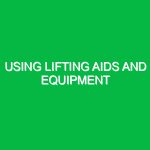In the realm of Health, Safety, and Environment (HSE), understanding the Principles of safe lifting is not just a guideline but a necessity. Lifting is an integral part of many occupations, from warehouses to construction sites. Yet, improperly executed lifting techniques can lead to serious injuries, costing both lives and productivity. This article delves into the core principles of safe lifting, highlighting its relevance in HSE, identifying potential hazards, and offering actionable safety precautions.
Understanding the Principles of Safe Lifting
The Principles of safe lifting encompass a set of guidelines designed to ensure that individuals can perform lifting tasks without putting their health at risk. These principles are foundational to ergonomics and occupational safety, aiming to reduce the likelihood of musculoskeletal injuries, which are prevalent in various industries. According to the Bureau of Labor Statistics, manual handling injuries account for a significant percentage of workplace injuries, underscoring the importance of adhering to safe lifting practices.
At its core, safe lifting involves understanding body mechanics, recognizing the weight and dimensions of the load, and employing techniques that minimize strain on the body. Implementing these principles not only fosters a safer work environment but also enhances efficiency and productivity.
Identifying Hazards and Risks Associated with Lifting
Common Hazards in Lifting
Every lifting task comes with its own set of risks. Understanding these hazards is the first step in mitigating them. Here are some common risks associated with improper lifting:
1. Musculoskeletal Disorders (MSDs)
One of the most significant risks of improper lifting is the development of musculoskeletal disorders. These injuries can affect the back, neck, shoulders, and legs, leading to chronic pain and disability. For example, a construction worker lifting heavy bricks without proper technique may experience severe lower back pain, rendering them unable to work for weeks.
2. Slips, Trips, and Falls
When lifting, individuals often overlook their surroundings. A cluttered workspace can lead to slips, trips, and falls, especially when carrying a load that obstructs one’s view. A personal anecdote from a warehouse supervisor illustrates this: one employee, while carrying a large box, tripped over a misplaced pallet, resulting in a sprained ankle and a halt in productivity.
3. Overexertion
Overexertion occurs when individuals attempt to lift loads that exceed their physical capability. This can lead to acute injuries, such as strains and sprains. For instance, an employee lifting a heavy piece of equipment without assistance may experience immediate muscle strain, resulting in a need for medical attention.
4. Improper Use of Equipment
Using lifting equipment incorrectly can also pose significant risks. For example, failing to secure a load on a forklift properly can lead to accidents and injuries. It’s crucial to be trained in the correct use of any lifting or transporting equipment. One case study from a manufacturing plant highlighted the importance of proper training; an untrained worker improperly operated a hoist, leading to a dropped load that injured a nearby colleague.
Safety Precautions and Best Practices for Safe Lifting
Implementing Safe Lifting Techniques
To mitigate the risks associated with lifting, several best practices can be adopted:
1. Assess the Load
Before lifting, evaluate the load’s weight and size. If it’s too heavy or awkward, seek assistance or use mechanical aids. For example, if a worker faces a large box that is too heavy to lift alone, they should use a dolly or ask a coworker for help. Understanding one’s limits is crucial in preventing injuries.
2. Plan the Lift
Planning involves identifying the path for the lift and ensuring that it is clear of obstacles. A well-thought-out plan can help prevent accidents. For instance, a logistics team might designate clear pathways in a warehouse, ensuring that employees know where to walk and where to lift without obstruction.
3. Use Proper Body Mechanics
Employing proper body mechanics is vital. Here are some techniques to follow:
- Stand close to the load, keeping your feet shoulder-width apart for balance.
- Bend at the hips and knees, not the waist, to lower yourself to the load.
- Keep the load close to your body, using your legs to lift rather than your back.
- Use smooth, controlled movements while lifting and avoid twisting your body.
For example, during a training session, a supervisor demonstrated the proper technique, leading to a noticeable reduction in lifting-related injuries in the following months.
4. Utilize Mechanical Aids
Whenever possible, use tools such as forklifts, hoists, or dollies. These devices can significantly reduce the physical strain on workers. A notable instance occurred in a retail setting where the introduction of a powered lifting device decreased the incidence of back injuries by 40% within a year.
5. Encourage Team Lifting
For heavier loads, team lifting is often the best approach. Workers should communicate clearly when lifting in pairs or groups to coordinate their movements. For instance, during construction projects, workers are often required to lift large beams together, necessitating clear communication and timing.
Regular Training and Awareness
Regular training sessions are crucial for reinforcing safe lifting principles. Workers should be educated on the risks associated with lifting and the best practices to mitigate these risks. Incorporating hands-on training can significantly enhance understanding and retention of safe lifting techniques. For instance, a manufacturing plant that conducted quarterly safety workshops reported a marked decrease in injuries related to lifting over two years.
Regulations and Standards Governing Safe Lifting
Understanding Compliance
Various regulations and standards govern the principles of safe lifting, aimed at protecting workers from injuries. The Occupational Safety and Health Administration (OSHA) sets forth guidelines that employers must follow. Key regulations include:
1. OSHA General Duty Clause
This clause requires employers to provide a workplace free from recognized hazards. This includes ensuring safe lifting practices are in place to protect workers.
2. ANSI Standards
The American National Standards Institute (ANSI) provides guidelines on manual lifting, emphasizing ergonomic practices to minimize risk.
3. NIOSH Lifting Equation
The National Institute for Occupational Safety and Health (NIOSH) has developed a lifting equation to evaluate lifting tasks and determine safe weight limits based on various factors, including load height and distance.
Conclusion: Prioritizing Safe Lifting
In conclusion, the Principles of safe lifting are essential in fostering a safe work environment. By understanding the potential hazards and implementing effective lifting techniques, workers can significantly reduce the risk of injuries. Regular training, awareness, and adherence to regulations not only protect employees but also enhance overall productivity. Remember, safety is not just a priority; it is a fundamental aspect of workplace culture.
By prioritizing safe lifting practices, we create a culture of care and responsibility, ensuring that every individual returns home safely after a day’s work. So, take the time to assess, plan, and lift safely; your body will thank you for it in the years to come.


